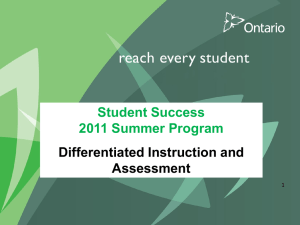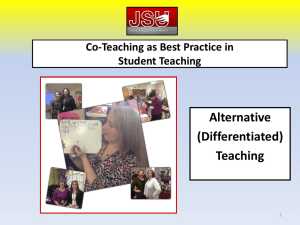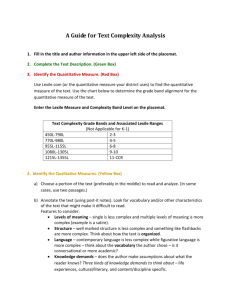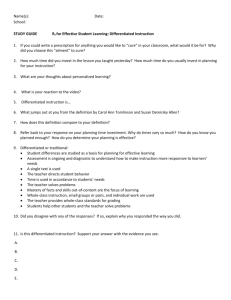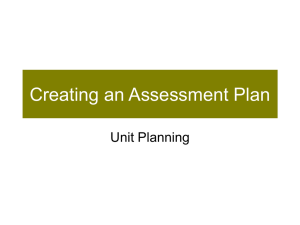DOC - EduGAINS
advertisement
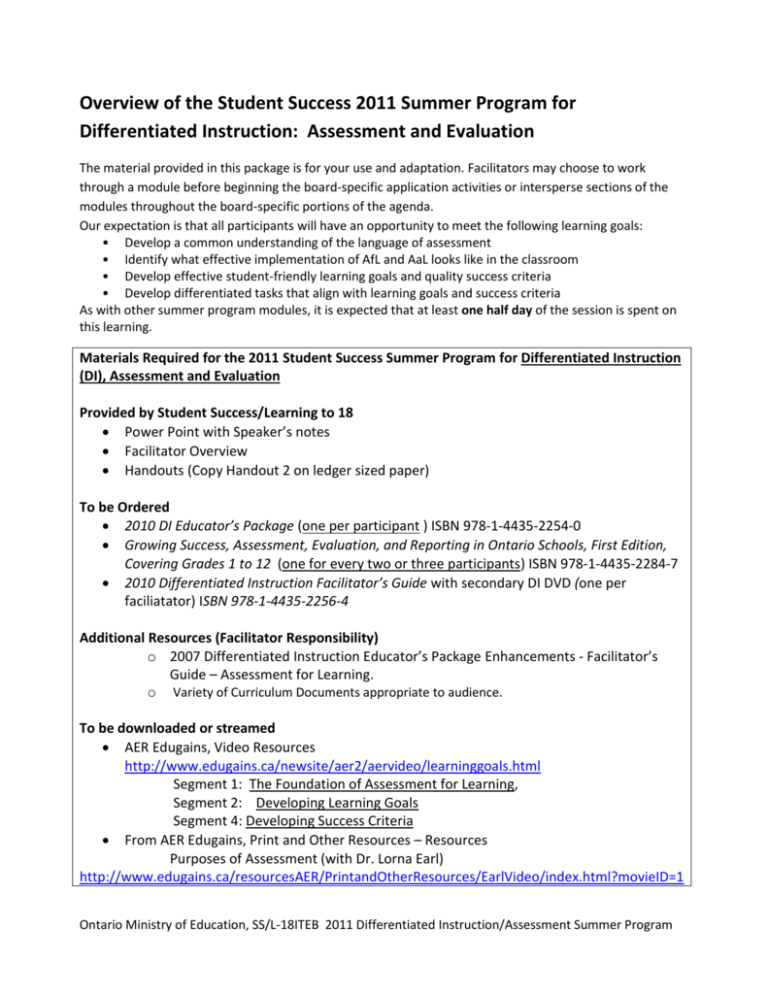
Overview of the Student Success 2011 Summer Program for Differentiated Instruction: Assessment and Evaluation The material provided in this package is for your use and adaptation. Facilitators may choose to work through a module before beginning the board-specific application activities or intersperse sections of the modules throughout the board-specific portions of the agenda. Our expectation is that all participants will have an opportunity to meet the following learning goals: • Develop a common understanding of the language of assessment • Identify what effective implementation of AfL and AaL looks like in the classroom • Develop effective student-friendly learning goals and quality success criteria • Develop differentiated tasks that align with learning goals and success criteria As with other summer program modules, it is expected that at least one half day of the session is spent on this learning. Materials Required for the 2011 Student Success Summer Program for Differentiated Instruction (DI), Assessment and Evaluation Provided by Student Success/Learning to 18 Power Point with Speaker’s notes Facilitator Overview Handouts (Copy Handout 2 on ledger sized paper) To be Ordered 2010 DI Educator’s Package (one per participant ) ISBN 978-1-4435-2254-0 Growing Success, Assessment, Evaluation, and Reporting in Ontario Schools, First Edition, Covering Grades 1 to 12 (one for every two or three participants) ISBN 978-1-4435-2284-7 2010 Differentiated Instruction Facilitator’s Guide with secondary DI DVD (one per faciliatator) ISBN 978-1-4435-2256-4 Additional Resources (Facilitator Responsibility) o 2007 Differentiated Instruction Educator’s Package Enhancements - Facilitator’s Guide – Assessment for Learning. o Variety of Curriculum Documents appropriate to audience. To be downloaded or streamed AER Edugains, Video Resources http://www.edugains.ca/newsite/aer2/aervideo/learninggoals.html Segment 1: The Foundation of Assessment for Learning, Segment 2: Developing Learning Goals Segment 4: Developing Success Criteria From AER Edugains, Print and Other Resources – Resources Purposes of Assessment (with Dr. Lorna Earl) http://www.edugains.ca/resourcesAER/PrintandOtherResources/EarlVideo/index.html?movieID=1 Ontario Ministry of Education, SS/L-18ITEB 2011 Differentiated Instruction/Assessment Summer Program Optional o Assessment DI Cards Sharing and Clarifying the Learning Goal(s) Identifying Success Criteria Sharing and Clarifying Success Criteria At the Board Chart paper, highlighters, markers Sticky notes – 3 different colours Computer, Speakers, LCD Projector, Internet Access Background Resources NOTE: - The other AER Video segments and the Viewer’s Guide for Learning Goals and Success Criteria will support facilitators in planning the other parts of this session Visible Learning, John Hattie chapters 9 and 10 The Art and Science of Teaching, Robert Marzano chapter 1 Advancing Formative Assessment in Every Classroom, Connie Moss, Susan Brookhart, chapters 1 and 2 Ontario Ministry of Education, SS/L-18ITEB 2011 Differentiated Instruction/Assessment Summer Program Agenda Learning Sequence Knowing the Learner Ontario Context Agenda, Handout Package and learning Goals Details/Notes (see Speaker’s Notes on slides) MINDS ON Group Profile – before the session begins As participants are entering they complete the Group Profile charts on the wall. Conversations – before the session begins Facilitators circulate and engage in conversation to assess the level of expertise with DI and knowledge of Growing Success Ontario Context These slides are common to all the Summer workshop presentations. Please use the slide notes to highlight the focus of the Ministry core priorities and Student Success/Learning to 18. Review the agenda pointing out the structure of the three part lesson. Ensure that the participants have all of the handouts. Review the learning goals for the session Materials (Photocopy a complete package of handouts for all participants) Slide 2 Chart Paper Markers or stickers Slides 3-7 Slides 8 -10 Handout Package Knowing the Learner Building Community Table Profile Table groups complete their profile, share highlights with the whole group and discuss experiences using class or student profiles as a basis for differentiation. Connections Slide This slide has been provided to support facilitators moving around the presentation. It provides links to key presentation slides and slides that provide support for the learning throughout the session. The slide can be accessed by clicking on the apples in the bottom right hand corner of any slide when it is presentation mode. By clicking on any of the links it will take you directly to that slide. Knowing the Learner Diagnostic Placemat Activity 1 – (Diagnostic Assessment for Learning, Assessment as Learning, and Assessment of Learning) Point out why the terms formative and summative are being replaced (Slide 14). Participants complete Placemat Activity #1 on their own and then Think Pair Share, followed by a whole group debrief. NOTE: Success criteria for this activity Ontario Ministry of Education, SS/L-18ITEB 2011 Differentiated Instruction/Assessment Summer Program Slides 11-12 Handout 1: Table Profile (one per table) Slide 13 Slides 14- 18 Handout 2: Placemat • Participants will articulate that it is how the assessment information is used that determines the purpose of the assessment. Participants will articulate that assessment is used to mean a set of actions undertaken by the teacher and the student to gather information about student learning. Consolidation of Assessment for as and of Learning Differentiated Activities for Consolidation (adapt to the readiness of the group) Participants read or view the materials appropriate to “where they are” or “how they would like to learn”. It is not necessary for all groups to report back to the whole group. NOTE: If the group has a clear understanding of assessment for, as and of learning the consolidation activity could be tailored to highlight the resource rather than the content. Differentiating Assessment Action Assessment Centres – Placemat Activity 2 Participants select a centre of interest; for, as or of learning and complete Placemat activity 2 . Each centre reports back to the whole group and participants fill in their Placemat Activity 2 charts. Slides 19-20 Video -Purposes of Assessment Handout 3: Assessment Growing Success 2010 DI Educator’s PackageEducator’s Guide Slides 21-23 Handout 2 : Placemat References: Growing Success p.31 Foundation of Assessment for Learning Connecting to DI Video Segment 1 - The Foundation of Assessment for Learning Participants use the Video Viewing Guide to capture their thinking as they watch the video The Foundation of Assessment for Learning. Table groups discuss their thoughts. Each table group member then reads a relevant section in Growing Success and shares any new information with the group so that it can be noted in the last column. This slide offers an opportunity to link to DI. Participants should see that having clearly articulated learning goals and success criteria is critical before DI can begin. Only the process, product, topic, entry points and learning environment may be differentiated. The Ontario Ministry of Education, SS/L-18ITEB 2011 Differentiated Instruction/Assessment Summer Program Slides 24-28 Handout 4: Guided Viewing for Foundations of Assessment for Learning Video - Foundation of Assessment for Learning Growing Success Slide 29 learning goals and success criteria remain the same for all students (IEP may allow for exceptions.) Developing Learning Goals Writing Effective Learning Goals Differentiating Tasks and Assessment Video Segment 2 – Developing Learning Goals Before Viewing Participants complete the Concept Attainment to consider the criteria for effective learning goals During Viewing Participants add to their Concept Attainment chart on criteria for effective learning goals Stop the video at strategic points to facilitate a discussion as required After Viewing Consolidate with participants the criteria for writing an effective learning goal. Slides: 30-33 Handout 5: Concept Attainment for Effective Learning Goals Video- Developing Learning Goals Subject/grade Specific Groups – Placemat Activity 3 Groups choose an overall expectation and, considering the criteria, create a learning goal from the overall expectation, consider what specific expectations support that overall expectation and write them as learning goals. Groups may exchange with peers to obtain feedback on the alignment of the expectations and goals. Slides 34 Differentiated Instruction Use Slide 35 to review the underlying principles of DI and the elements of effective differentiated instruction. Use more of the Educator’s Package and the DI Introductory Professional Learning Module if required to review/deepen understanding of DI. Slide 35- 38 Handout 3: Placemat A variety of curriculum documents appropriate for the audience. 2010 DI Educator’s Package Handout 3: Placemat Differentiating Tasks and Assessment - Subject Pairs / Triads – Placemat Activity 3 (cont’d) Based on their learning goals, small groups think of differentiated ways to provide opportunities for students to demonstrate the learning goals. Groups exchange with peers to obtain feedback on the differentiated task aligns with the learning goals. Ontario Ministry of Education, SS/L-18ITEB 2011 Differentiated Instruction/Assessment Summer Program Developing Success Criteria Gathering Evidence of Learning – Triangulation Making Connections Video Segment 3 – Developing Success Criteria Placemat Activity 3 (cont’d) Participants watch the video using the three questions as a lens for viewing. After viewing ensure that there is a clear understanding of success criteria. Developing Success Criteria – Subject Pairs /Triads The groups develop success criteria for the tasks they developed, ensuring that the same success criteria apply to all of the tasks. They note the success criteria on the placemat (Activity 3). Put up poster paper with a triangle drawn on it. At each of the points the facilitator has written an O, P, C Evidence Sort – Triangulation Table groups think of all the ways they know that students are learning. Participants list one idea per sticky note, using different colours to indicate assessment for, as and of learning. Next they categorize their ideas under the three headings; observations, conversations and products and place them on the triangles posted in the room. Patterns and trends Discuss the patterns and trends that emerge form the wall charts. Participants return to their learning goals and related tasks on the placemat to check for a balance of evidence sources. (Placemat Activity 3 – Question 4) Use this slide to clarify how all of the elements discussed in this session pertain to the three assessment questions and how they look differently for students and teachers. Table groups make connections to Placemat Activities. Slides 39-40 Video Segment 3 - Developing Success Criteria Handout 2: Placemat Slide 41 -46 Small post it notes – 3 colours Chart paper on the wall Handout 2: Placemat Slide 47 -48 CONSOLIDATION Consolidation Five Strategies Review the five strategies that support assessment for, as and of learning. Video – DI Secondary Understanding Canadian Law Participants view the video and make connections to the Five Strategies on Handout 6. Reflection Reflection on Learning Goals - Table Groups Table groups reflect on the extent to which they have met the learning goals of the Ontario Ministry of Education, SS/L-18ITEB 2011 Differentiated Instruction/Assessment Summer Program Slide 50 – 51 Video segment – DI Secondary DVD – Understanding Canadian Law Handout 6: Guided Viewing – Five Strategies Consolidation Slides 52-54 session. Exit Cards Individuals complete exit cards prepared by the facilitator according to local needs/context. Conclusion Please stress the importance of providing session feedback via the on-line survey. Ontario Ministry of Education, SS/L-18ITEB 2011 Differentiated Instruction/Assessment Summer Program Survey Monkey Session Feedback If you have questions, please contact: Anne Clifton Karen Greenham John Piper 416-325-4712 416- 325-4711 416 314 7277 anne.clifton@ontario.ca karen.greenham@ontario.ca John.piper@ontario.ca Student Success/Learning to 18 Implementation, Training and Evaluation Branch 900 Bay Street, 4th Floor Toronto ON M7A 1L2 Fax: 416-327-6749 Ontario Ministry of Education, SS/L-18ITEB 2011 Differentiated Instruction/Assessment Summer Program
